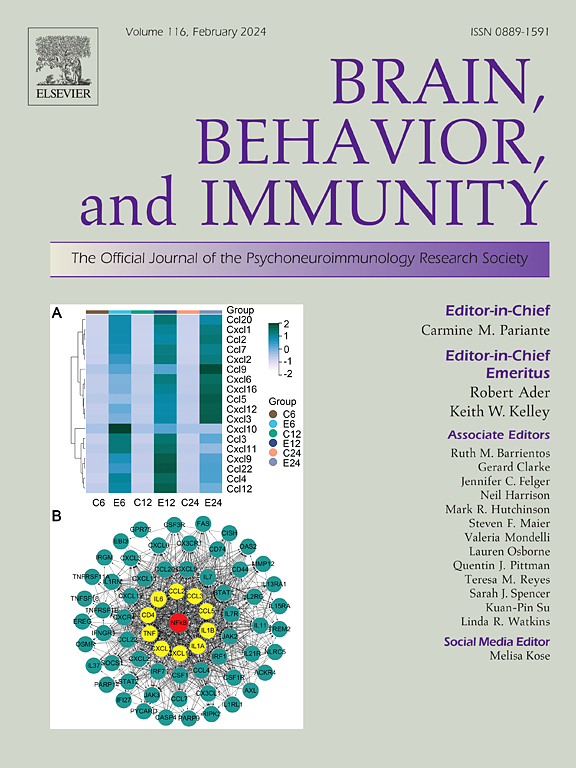Microglial cGAS-STING-TBK1 activation in paraventricular thalamus mediates sleep and emotional disturbances in lupus mice
IF 7.6
2区 医学
Q1 IMMUNOLOGY
引用次数: 0
Abstract
Sleep and emotional disturbances are prevalent in systemic lupus erythematosus (SLE) patients, yet the neuroinflammatory mechanisms remain unclear. Here, we investigated this issue using pristane-induced lupus (PIL) mice. We firstly confirmed that PIL mice exhibited progressive fragmentation of NREM sleep and decreased cumulative sleep time, correlating with blood–brain barrier (BBB) leakage and IgG deposition in the paraventricular thalamus (PVT). Concurrently, PVT neurons showed aberrant excitatory activity, including a high level of cFos expression, decreased amplitude and increased rate of Ca2+ transients during wakefulness. Bulk RNA sequencing and protein analyses demonstrated upregulation of the cyclic GMP-AMP synthase (cGAS) −stimulator of interferon genes (STING) −TANK-binding kinase 1 (TBK1) activation pathway in PVT microglia, with elevated phosphorylation of STING (pSTING) and TBK1 (pTBK1), promoting synthesis of pro-inflammatory cytokines. Selectively knockdown STING in microglia effectively normalized PVT neuronal excitability, restored sleep homeostasis, and ameliorated anxiety/depression-like behaviors. Notably, we identified selective expression of cannabinoid receptor type 2 (CB2R) in PVT microglia. Pharmacological CB2R activation could inhibit TBK1 phosphorylation, attenuate microglial inflammatory responses, and improve sleep and emotional disturbances. Our findings elucidate a novel neuroimmune axis in SLE-related neuropsychiatric symptoms, offering potential therapeutic avenues for mitigating neuroinflammation and associated behavioral comorbidities in lupus.
室旁丘脑小胶质细胞cGAS-STING-TBK1激活介导狼疮小鼠的睡眠和情绪障碍
系统性红斑狼疮(SLE)患者普遍存在睡眠和情绪障碍,但其神经炎症机制尚不清楚。在这里,我们用前列腺素诱导的狼疮(PIL)小鼠来研究这个问题。我们首先证实,PIL小鼠表现出NREM睡眠的进行性断裂和累积睡眠时间的减少,这与血脑屏障(BBB)渗漏和室旁丘脑(PVT) IgG沉积有关。同时,PVT神经元表现出异常的兴奋性活动,包括cFos表达水平高,清醒时Ca2+瞬态振幅下降和速率增加。大量RNA测序和蛋白质分析表明,PVT小胶质细胞中环GMP-AMP合成酶(cGAS) -干扰素基因刺激因子(STING) - tank结合激酶1 (TBK1)激活途径上调,STING (pSTING)和TBK1 (pTBK1)磷酸化升高,促进促炎细胞因子的合成。选择性地抑制小胶质细胞中的STING可有效地正常化PVT神经元的兴奋性,恢复睡眠稳态,改善焦虑/抑郁样行为。值得注意的是,我们发现大麻素受体2型(CB2R)在PVT小胶质细胞中选择性表达。药理激活CB2R可抑制TBK1磷酸化,减轻小胶质细胞炎症反应,改善睡眠和情绪障碍。我们的研究结果阐明了sle相关神经精神症状中的一种新的神经免疫轴,为减轻狼疮的神经炎症和相关行为合并症提供了潜在的治疗途径。
本文章由计算机程序翻译,如有差异,请以英文原文为准。
求助全文
约1分钟内获得全文
求助全文
来源期刊
CiteScore
29.60
自引率
2.00%
发文量
290
审稿时长
28 days
期刊介绍:
Established in 1987, Brain, Behavior, and Immunity proudly serves as the official journal of the Psychoneuroimmunology Research Society (PNIRS). This pioneering journal is dedicated to publishing peer-reviewed basic, experimental, and clinical studies that explore the intricate interactions among behavioral, neural, endocrine, and immune systems in both humans and animals.
As an international and interdisciplinary platform, Brain, Behavior, and Immunity focuses on original research spanning neuroscience, immunology, integrative physiology, behavioral biology, psychiatry, psychology, and clinical medicine. The journal is inclusive of research conducted at various levels, including molecular, cellular, social, and whole organism perspectives. With a commitment to efficiency, the journal facilitates online submission and review, ensuring timely publication of experimental results. Manuscripts typically undergo peer review and are returned to authors within 30 days of submission. It's worth noting that Brain, Behavior, and Immunity, published eight times a year, does not impose submission fees or page charges, fostering an open and accessible platform for scientific discourse.

 求助内容:
求助内容: 应助结果提醒方式:
应助结果提醒方式:


